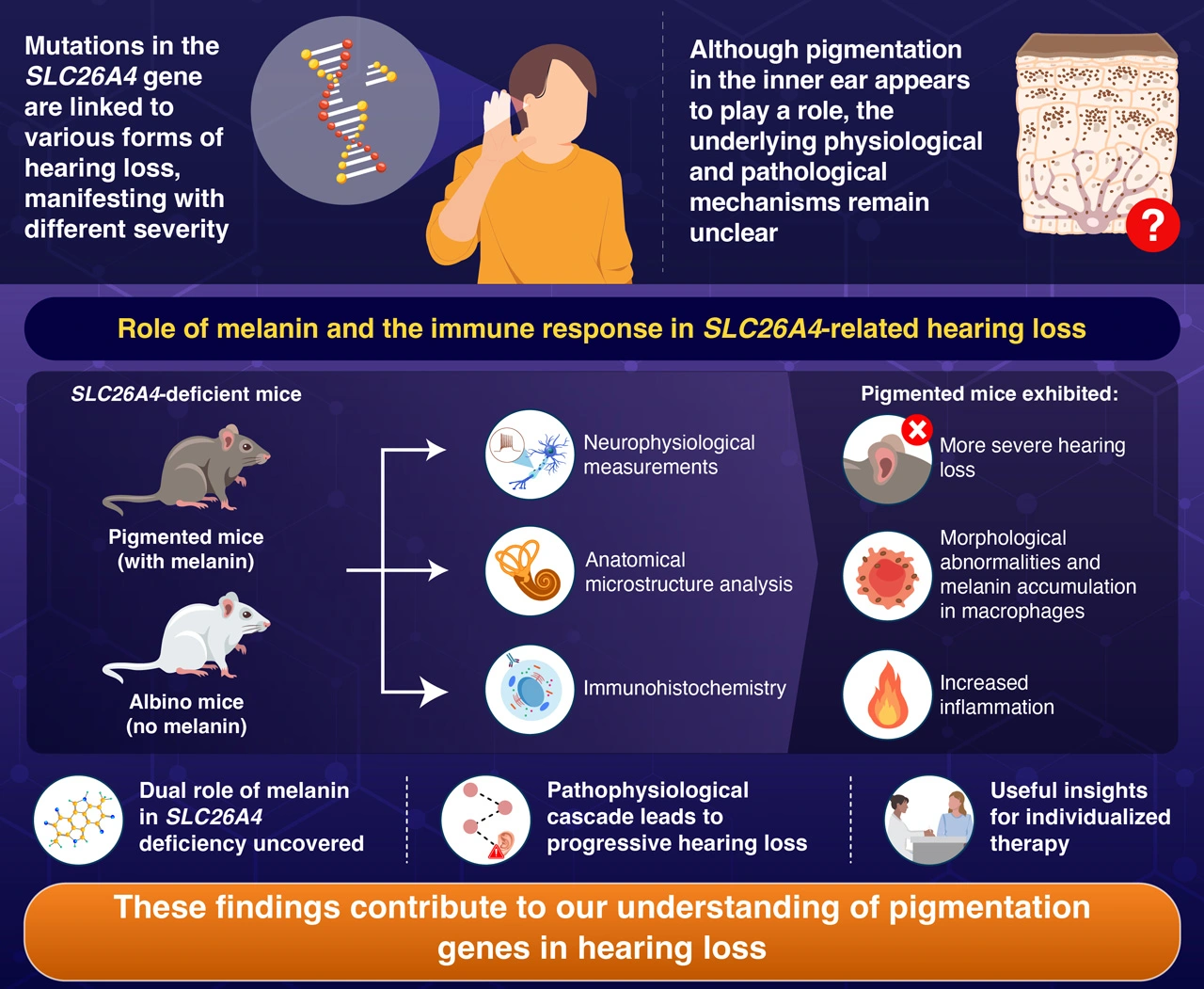Melanin can either protect or worsen hereditary hearing loss depending on genetic context, as reported by researchers from Japan. Using genetically engineered mice lacking the SLC26A4 gene, the researchers found that problems with melanin degradation led to its pathological accumulation in the inner ear, causing chronic inflammation and macrophage activation. These findings could inform new therapeutic strategies to minimize some forms of hereditary hearing loss.
Possible Link Between Melanin and Hearing Loss

Aoki et al. (2025) | Neurobiology of Disease | 10.1016/j.nbd.2025.106962
Although hereditary hearing loss affects millions worldwide, the factors that determine its severity remain poorly understood. One particularly puzzling aspect is the wide variation in symptoms among patients with identical genetic mutations, even within the same family. This variability suggests that additional factors beyond the primary genetic defect may influence disease progression, but identifying them has proven challenging.
Interestingly, recent research has revealed that a complex relationship exists between melanin pigmentation and the proper functioning of the inner ear. However, the specific mechanisms linking melanin to auditory health remain unclear. While some studies suggest melanin provides protective antioxidant effects, others indicate it may contribute to inflammatory processes under certain pathological conditions.
To shed light on this topic, a research team led by Junior Associate Professor Taku Ito from Institute of Science Tokyo (Science Tokyo), Japan, explored how pigmentation influences hearing loss progression using genetically modified mice. Their paper, published online in Neurobiology of Disease on May 17, 2025, in Volume 212, reveals that melanin plays a dual role in hereditary hearing loss, acting as a protector or a pathological trigger depending on the underlying genetic condition.
The researchers compared two groups of mice lacking the SLC26A4 gene, whose mutations are commonly associated with hereditary hearing loss in humans. One group consisted of albino (non-pigmented) mice, whereas the other group had normal pigmentation. Using advanced three-dimensional morphological analysis and dimensionality reduction techniques, they explored variations in hearing, gene expression, and immune cell behavior between the two groups.
The team found that pigmented mice exhibited more severe hearing loss and dramatically enlarged macrophages-a type of activated immune cell-in their inner ears. Remarkably, transcriptomic analysis revealed that melanin accumulation wasn't due to overproduction but rather to impaired degradation mechanisms. The researchers found no increase in melanin synthesis genes, suggesting that metabolic disruptions prevent proper melanin clearance. "We found significant differences in macrophage morphology and immune responses between non-pigmented and pigmented SLC26A4-deficient mice," explains Ito. "Our analyzes suggested that melanin presence markedly alters macrophage activation pathways."
Based on these findings, the team proposed a novel pathological cascade: loss of SLC26A4 function triggers metabolic stress, impairing melanin degradation and then leading to pigment accumulation that chronically activates immune cells and promotes inflammation. This cascade ultimately exacerbates hearing loss in pigmented individuals while sparing non-pigmented individuals.
Taken together, the results of this work have notable implications in terms of both basic science and clinical medicine. "Our study highlights the context-dependent dual role of melanin-both as a protective factor and a pathological trigger-and points to the potential for applying these findings to future personalized medicine," notes Ito. For example, pigmentation status could serve as a biomarker for predicting disease severity. Similarly, future therapeutic strategies for hereditary hearing loss might target the melanin degradation pathway or modulate immune responses to prevent the inflammatory cascade that drives hearing loss progression. Also, the insights gained from this study suggest that ethnic variations exist in susceptibility to auditory disorders.
Let us hope these results pave the way to a more comprehensive understanding of hereditary hearing loss, as well as new methods to mitigate it!
Reference
- Authors:
- Natsuki Aoki1, Ayako Maruyama1, Toru Miwa2, Natsuko Kurata1, Keiji Honda1,
Yoshiyuki Kawashima1, Takeshi Tsutsumi1, Taku Ito1*
- Title:
- Influence of melanin and macrophage activation on hearing loss in SLC26A4 deficient mice
- Journal:
- Neurobiology of Disease
- Affiliations:
-
1Department of Otorhinolaryngology, Institute of Science Tokyo, Japan
2Department of Otolaryngology, Head and Neck Surgery, Graduate School of Medicine, Japan






